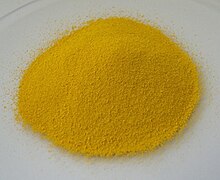Bismuth compounds

Bismuth forms mainly trivalent and a few pentavalent compounds. Many of its chemical properties are similar to those of arsenic and antimony, although much less toxic.[1]
Oxides and sulfides
At elevated temperatures, vaporized bismuth metal and oxygen combine into the yellow trioxide, Bi
2O
3.[2][3] At temperatures above 710 °C, this (molten) oxide corrodes all known oxides and even platinum.[4] It forms two series of oxyanions in basic conditions: linear, chain-polymeric BiO−
2; and cubic BiO3−
3. In Li
3BiO
3, the anion forms the octamer Bi
8O24−
24; in Na
3BiO
3, the tetramer.[5]
The dark red bismuth(V) oxide, Bi
2O
5, is unstable, liberating O
2 gas upon heating.[6] The compound NaBiO3 is a strong oxidant.[7]
Bismuth sulfide, Bi
2S
3, occurs naturally in bismuth ores,[8] but can be synthesized from molten bismuth and sulfur.[9]
Halides
In oxidation state +3, bismuth forms salts with all the
4.[10]
The oxidation state +5 is less frequently encountered. One such compound is the powerful oxidant and fluorinator, BiF
5. It is also a strong fluoride acceptor, forming the XeF+
3 cation from xenon tetrafluoride:[10]
- BiF
5 + XeF
4 → XeF+
3BiF−
6
The
] [Bi5+
9] [HfCl2−
6]
3.[5]: 50 Other polyatomic bismuth cations are also known, such as Bi2+
8, found in Bi
8(AlCl
4)
2.[11]
There is a true monoiodide, BiI, which contains chains of Bi
4I
4 units. BiI decomposes upon heating to the triiodide, BiI
3, and elemental bismuth.[5]
Bismuth forms at least two "monobromides": one isostructural to "BiCl"[citation needed] and one isostructural to Bi
4I
4.[5]
Aqueous species and the bismuthyl cation
In
ion is solvated to form the aqua ion Bi(H
2O)3+
8 in strongly acidic conditions.[12] At pH > 0 polynuclear species exist, the most important of which is believed to be the octahedral complex [Bi
6O
4(OH)
4]6+
.[13]

Bismuth oxychloride (BiOCl) and bismuth oxynitrate (BiONO3) stoichiometrically appear simple anionic salts of the bismuthyl(III) cation (BiO+), which commonly occurs in aqueous bismuth compounds. However, in the case of BiOCl, the salt crystal forms alternating plates of Bi, O, and Cl atoms. Each oxygen coordinates with four bismuth atoms in the adjacent plane.[14]
Bismuthine and bismuthides
Unlike the lighter
In 2014 researchers discovered that sodium bismuthide admits bulk 3D
3Bi) is too unstable to be used in devices without packaging, it may offer distinct efficiency and fabrication advantages over planar graphene in semiconductor and spintronics applications.[16][17]
Applications
Coloration

- Bismuth subnitrate is an iridescent component of glazesand paint pigment.
- Bismuth oxychloride is a pigment and cosmetic.[14]
- Bismuth vanadate is an opaque yellow pigment used by some artists' oil, acrylic, and watercolor paint companies, primarily as a replacement for the more toxic cadmium sulfide yellows in the greenish-yellow (lemon) to orange-toned yellow range. It performs practically identically to the cadmium pigments in UV resistance, opacity, tinting strength, and inertness when mixed with other pigments. The most commonly-used variety by artists' paint makers is lemon in color.
- The vanadate also replaces older zinc, lead, and strontium chromate pigments for much the same reason. With a green pigment and barium sulfate (for increased transparency), it can also replace the greenish-tinted lead sulfatemixture.
- Vanadate paints are also used, on a limited basis due to its cost, on vehicles.[18][19]
- Bismuth(III) salts (oxide, subcarbonate or subnitrate) color crackling microstar (dragon's egg) pyrotechnics yellow.[20][21][self-published source?]
Electrics and electronics
- Bismuth strontium calcium copper oxide (BSCCO) is a superconducting compound family discovered in 1988. Its members exhibit the highest superconducting transition temperatures at standard pressure.[22]
- δ-Bismuth oxideis a solid electrolyte for oxygen. This form is stable only at high temperature, but can be electrodeposited well below this temperature in highly alkaline solution.
- Bismuth germanate is a scintillator in X-ray and gamma ray detectors.
Chemical catalysis
- Bismuth is used in a acrylic fibers.[24]
- Bismuth metal on glassy carbon catalyzes the electrochemical reduction of CO2 to CO.[25]
- Bismuth catalyzes arylboronic pinacol ester fluorination through a BiIII/V cycle.[26]
Other
- Bismuth metal is an ingredient in some lubricating greases.[27]
See also
References
- ISBN 0-08-043748-6.
- ^ Wiberg, p. 768.
- ^ Greenwood, p. 553.
- ^ Krüger, p. 185
- ^ ISBN 978-0-7514-0389-3.
- ISBN 978-3-11-011451-5.
- ^ Greenwood, p. 578.
- ISBN 978-1-4400-5235-4.
- ^ Greenwood, pp. 559–561.
- ^ a b Suzuki, p. 8.
- ^ ISBN 978-0-12-023617-6.
- .
- PMID 11198855.
- ^ a b c d Krüger, p. 184.
- ^ "bismuthide". Your Dictionary. Retrieved 2020-04-07.
- ^ "3D counterpart to graphene discovered [UPDATE]". KurzweilAI. 20 January 2014. Retrieved 28 January 2014.
- S2CID 206552029.
- .
- ISBN 978-1-56990-352-0.
- .
- ISBN 978-1-4116-8574-1.
- ^ "BSCCO". National High Magnetic Field Laboratory. Archived from the original on 12 April 2013. Retrieved 18 January 2010.
- ISBN 978-0-12-752178-7.
- ISBN 978-0-8493-0485-9.
- PMID 23735115.
- S2CID 210698047.
- ISBN 978-1-4020-8661-8.
